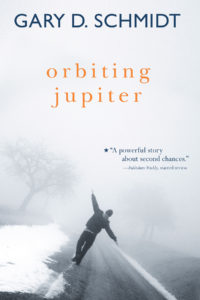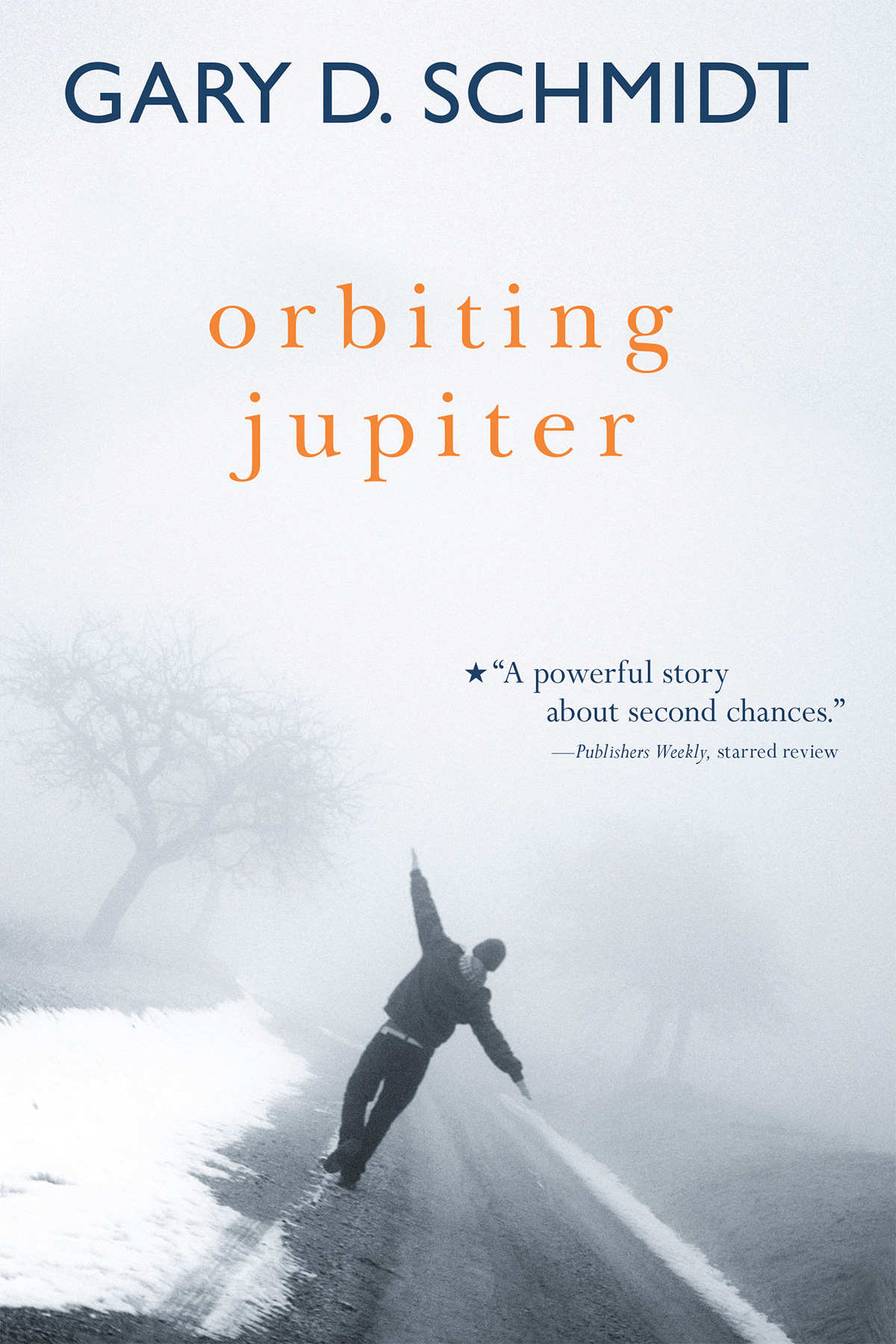craft review by Anne-Marie Strohman
Gary Schmidt’s Orbiting Jupiter is a sparse text–a mere 181 pages–and it sits right between middle grade and YA, with its twelve-year-old narrator, Jack, and his fourteen-year-old foster brother, Joseph, at the center of the story. In tone and feel, it’s akin to Patricia MacLachlan’s The Poet’s Dog, an incredibly poetic novella. Schmidt’s poetry goes beyond economy of words, and incorporates a number of different poetic techniques. One of the most effective is repetition. He uses both direct repetition (a word or phrase repeated immediately) and delayed repetition (circling back to a word or phrase or idea at various points in the text) to affect pace, to expand the meaning of the text, and to amplify the emotions of the reader.
Jack narrates Orbiting Jupiter, telling the story of when Joseph–who comes from an abusive household and has fathered a baby–comes to live with his family on their farm in rural Maine. Joseph wants one thing: to find his daughter, Jupiter, and he wants to enlist Jack’s help to find her. In this tale of love, devotion, family, isolation, and connection, Schmidt’s use of repetition conveys the feelings of the narrator and characters in the book, and adds poignancy for the reader.
Delayed Repetition to Expand Meaning (and Add a Little Humor)
This first example of repetition is simple and subtle, but it effectively adds meaning and humor. About halfway through the novel, it’s Christmas morning. Jack describes the morning milking cows and having breakfast before presents. Then he jumps into a paragraph about the presents:
The usual stuff. Wool socks for Joseph and me. And wool shirts. New jeans. New boots. A new Barlow knife for me, a new Buck knife for Joseph. Books–pretty good, except Joseph got a copy of Walden, which looked about as boring as wool socks. (113)
Jack starts his list with wool socks, and then returns to them as a comparison item–Walden to wool socks. The repetition makes the paragraph feel complete in its circular list. It also tells us about Jack’s attitude toward Walden and toward wool socks. The disjunction between a literary classic like Walden and boring old wool socks creates a moment of levity in a serious novel.
Action: When you have a list paragraph, try using the first item on the list repeated at the end to reveal something about the last item. Experiment with changing the order of the items until you find something that works. Bonus points for using the repetition to add humor.
Delayed Repetition as an Emotional Barometer
A more blatant example of repetition again signals the emotions of the characters, but also reveals emotional change. Throughout the story, Jack keeps track of how many times Joseph smiles. On page 6, when Joseph has acclimated to the cows a bit, he rubs Rosie’s rump, and Rosie moos to him. As Jack says, “Rosie told him she loved him. That was the first time I saw Joseph smile. Sort of.” On page 17, Joseph teaches Jack how to throw rocks at the church bell more effectively. When Jack is successful, he’s proud. “And Joseph? His second smile. Sort of.” The first half of the book collects five sort-of smiles. And then Jack and Joseph have a snow fight while they’re shoveling:
. . . and when I turned around, another shovelful across my chest and in my face, and Joseph was smiling and laughing.
Joseph was smiling and laughing.
Number six–not even sort of. (118)
Schmidt uses a directly repeated sentence “Joseph was smiling and laughing” to draw attention to the anomaly. Then he uses the “not even sort of” to define the smile and show a change in Joseph. He feels at home and is able to play and find joy in a simple snow fight.
Action: Find a physical barometer for a character’s emotional state. Repeat it–not too often. Then break the pattern to show change–to give your readers another signal of the character’s feelings.
Immediate Repetition to Show the Slow Passing of Time
Repetition can do more than reveal the characters’ feelings, it can also evoke feelings in the reader, drawing them into the characters’ experiences. When Jack’s family and Joseph are waiting to hear back from the social worker about Joseph’s daughter, Jupiter, time seems to pass very slowly. But Schmidt skips over all of the days. He uses the combination of repeated phrases and sentence structures to give readers the feeling of time passing slowly, but over the course of only three sentences:
But the days dragged on, and they grew heavy with snow again.
The days dragged on, and they grew heavy with cold again.
The days dragged on, and they grew heavy with waiting. (134)
In the first two sentences, the only change is the word “snow” to “cold.” In the third sentence, that word becomes “waiting” and the “again” is dropped, changing the number of ending syllables from three to two, which leaves the reader hanging–waiting for the final syllable to complete the pattern. The sentences give the sense that the days are all the same, that it is tiresome to wait, and that quite a long time is passing.
Action: When you need time to pass quickly in the text but with a feeling of slowness, try using repeated phrases and sentence structures to amplify the feeling in few words.
Delayed Repetition to Expand Meaning and Emotional Resonance
Throughout the novel, Schmidt reminds readers of incidents and earlier scenes, using repetition to inform the emotion of the current scene, which then creates an explosion of emotion for both the characters and the readers. For the following example, it’s important to know three things. 1) After telling the story of Mary and Joseph on Christmas Eve–the first time Joseph has heard it–and having a conversation with Joseph, Reverend Ballou nearly starts crying. 2) Joseph has a special relationship with the cow Rosie. He rubs her rump and she calms, and she’s always mooing her love to him. Every time Joseph milks Rosie, he leans into her. 3) Joseph does not like for people to touch him. Every time someone reaches toward him or touches him, he flinches.
The first item, Reverend Ballou’s crying, occurs two pages before this example. The other two have been established in numerous scenes. Watch for how these three pieces of information create resonance within the scene. And watch for how repeated phrases within the scene also heighten the emotion. Joseph has just opened his last Christmas present–a note saying that Jack’s parents will help him to find his daughter, Jupiter.
He put the paper back into the envelope. He slipped the envelope between the pages of Walden. And no kidding, watching him, I thought he was going to start bawling, just like Reverend Ballou.
He walked over to my mother and she put her arms around him and he put his arms around her and he leaned into her–the way he did with Rosie.
Then my father came up behind him. He put his hand on Joseph’s back.
Christmas is the season for miracles, you know. Sometimes they come big and loud, I guess–but I’ve never seen one of those. I think probably most miracles are a lot smaller, and sort of still, and so quiet, you could miss them.
I didn’t miss this one.
When my father put his hand on Joseph’s back, Joseph didn’t even flinch. (114-15)
Within this section, the repetition of phrases deliberately slows down the pace of the prose. In the first two sentences, “the envelope” could have been used only once, but by repeating the full noun instead of using a pronoun, Schmidt shows us through the pace of the language the deliberate action of Joseph placing the envelope in (what will become) his prized book.
The sentence with Jack’s mother also has a slow pace with images that pile up with the repeated “and”s. The sentence could have stopped with “He walked over to my mother and she put her arms around him.” But adding the next two phrases amplifies the moment–he puts his arms around her AND he leans into her. The comparison with the action to leaning into Rosie again amplifies the emotion of the moment.
In the father moment, Schmidt interrupts the action with a full paragraph to draw attention to the moment, and he ends with the significance: “Joseph didn’t even flinch.” Schmidt uses repetition to connect back to the main image after the interruption, but the repeated phrase also draws attention to that significant action: “He put his hand on Joseph’s back. . . . When my father put his hand on Joseph’s back.”
This is the moment in the story when Joseph feels safest and most loved. The comparison to Reverend Ballou harkens back to an emotional moment in the text, and so amplifies this moment. The comparison of Joseph’s lean into Jack’s mother to his lean into Rosie shows that he feels content and safe and loved. And the final image of Joseph not flinching reinforces his feeling a part of the family.
Action: Look for places to pull earlier images or scenes into the scene you’re working on to add emotional resonance. Use repetition to deliberately slow the pace of your prose and to draw attention to significant actions.
Schmidt uses repetition throughout Orbiting Jupiter to evoke emotions in his readers. With directly repeated sentences and phrases, with images repeated periodically in the text, and with images and scenes recalled in later scenes, Schmidt leverages the moments he has created to amplify the meaning and emotion of individual scenes and of the story as a whole. And he does it all to make his readers feel.
Anne-Marie Strohman (co-editor) writes picture books, middle grade novels, and young adult short stories and novels. She is trained as a teacher, an editor, and a scholar, specializing in Renaissance Literature. She holds an MFA in Writing for Children and Young Adults from Vermont College of Fine Arts and is an active member of SCBWI. Find her at amstrohman.com and on Twitter @amstrwriter.

COMMENTs:
0